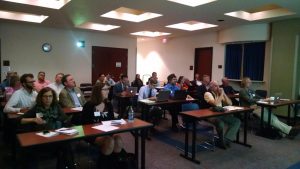EM+V 2.0 Workshop Summary
 Last week (Oct. 6, 2016), the Virginia Energy Efficiency Council held a successful workshop for utility staff, evaluators, regulators, implementers and other stakeholders on EM+V 2.0 (Evaluation, Measurement + Verification).
Last week (Oct. 6, 2016), the Virginia Energy Efficiency Council held a successful workshop for utility staff, evaluators, regulators, implementers and other stakeholders on EM+V 2.0 (Evaluation, Measurement + Verification).
This past spring, while we at the VAEEC were drafting our comments and collecting those from member organizations to the State Corporation Commission on the establishment of EM+V protocols, we took the opportunity to discuss this concept of “Enhanced EM+V”, “EM+V 2.0” or “Automated EM+V”. For the purposes of this post, we will use the term “EM+V 2.0” moving forward. As we stated in our comments, “these methods can provide opportunities for utilities and regulators to gain program insights in near real-time, speed up the evaluation process and potentially reduce the associated costs.”
During a conference call with our utility members to review and provide feedback on our comments, there was general agreement that a workshop to delve deeper into this complex topic would be useful. In the VAEEC’s role as a resource provider to our members and stakeholders, it made sense for us to take this on.
Our expert presenters came from diverse backgrounds, which allowed our participants to learn about EM+V 2.0 from a variety of different perspectives. Our presenters included:
- Katherine Johnson, Johnson Consults
- Maggie Molina, ACEEE
- Jake Oster, EnergySavvy
- Jessica Granderson, LBNL
- Tim Pettit, DNV GL
Katherine began the workshop with a quick primer on EM+V in general, including why evaluation is necessary for utility programs and the advantages and challenges of EM+V 2.0. She also discussed how EM+V 2.0 fit into the bigger picture and provided some examples of which programs it is useful to evaluate and which ones it may not be useful for. She also briefly mentioned her work as the independent evaluator in Arkansas and how that evaluation model works.
Following Katherine, was Maggie Molina with ACEEE who discussed ACEEE’s work in this field and discussed the findings from their report on the subject.
Next, was Jake Oster who works for EnergySavvy, a company whose software is used in this field. Jake discussed their product and provided several client case studies on the residential side.
Jessica Granderson with the Lawrence Berkeley National Lab presented on the EM+V 2.0 pilot programs they are doing as well as providing some examples of commercial EM+V 2.0.
Our last speaker of the day was Tim Petit who summarized some of the content already discussed by previous speakers and went into further detail about a NEEP report that came out recently.
All of their presentations can be accessed via links above and found on our resources page.
Following all of the presentations, we welcomed all of the presenters back to the front of the room for a panel discussion on what had been previously discussed, to answer questions and to start the dialogue on next steps.
We plan to follow up with participants with a survey to get feedback on how to continue the conversation.
From my perspective, simply having the number of participants we had and knowing they were engaged on the issue made this workshop a success. We appreciated the thoughtful questions and the discussion that ensued.
